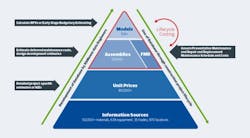Using Cost Item Assemblies to Improve Estimating Accuracy
Developing accurate, thorough and defendable cost estimates on a consistent basis is an arduous and – sometimes – imposing undertaking. Every project estimate can take on a life of its own, with unique needs and characteristics ranging from challenging architectural and engineering design to meticulous and precise construction execution details. And we haven’t even mentioned other important factors such as geographic impact, resource availability and prevailing market conditions, which usually play determining roles in the overall cost estimate.
Striving to achieve better cost estimate accuracy is not new. It’s been part of the estimating landscape forever. Understanding the underlying causes of inaccuracy and how to improve them in order to deliver a better outcome is more difficult.
Understanding the Root Causes of Inaccurate Estimates
It is usually not one single cause but a combination of important input factors that contribute to cost estimates being less accurate, less thorough and less defendable than hoped for. Three of the more significant root causes of inadequate cost estimates are:
- Inaccurate Cost Data: Access to accurate line-item cost data is extremely important and may be, in fact, the most important of these causes. Not having a reliable database catalog of material, labor and equipment costs to accurately price the scope of work according to prevailing market conditions will derail any estimate.
- Incomplete Scopes of Work: Ensuring that the project or task is adequately represented by a tight scope of work greatly reduces the possibility of missed or incorrect work elements and increases the probability of producing a more accurate cost estimate.
- Inconsistent Processes: For most organizations that produce cost estimates as a key component of their business operations, this becomes the single most critical aspect of developing consistently accurate cost estimates. Capturing, packaging, and applying consistent methods of developing estimates helps every cost estimator (from expert to novice), ensures organizational best practices are applied and creates a repeatable process for developing streamlined reviews and easily applied QA governance methods.
Assemblies Help Eliminate the Root Causes of Inaccuracy
Using cost item assemblies can counter the root causes mentioned above. Assemblies help estimators and other stakeholders better understand the project and its major components without getting buried in the project details at the outset of an estimate.
Cost item assemblies help create component-type visualizations and produce detailed cost item listings of the project scope, combatting the issue of unreliable cost data. Assemblies help ensure completeness of scope by delivering repeatable items and tasks stored as pre-defined components in an assembly catalog.
When it comes to processes, assemblies allow for greater efficiency because, over time and use, they become a “tailored solution” that forms part of the fabric of the estimating organization. When used consistently, assemblies create value in the process because they become known and trusted components to estimators, vetted for scope completeness and price accuracy, and make for an easily repeatable step over many projects, helping establish a consistent process.
Assemblies Increase Estimate Confidence
One or more individual cost line items from a construction cost book are used to create an assembly. In essence, an assembly is a collection of cost line items. The assembly is created by grouping items necessary to construct a scope component. For example, estimating for a linear foot of an interior office wall might require the estimator to individually seek out and select from the construction cost book a dozen or so cost line items (e.g., drywall, base board, wall studs, tape, spackle and finishing, etc.).
This pyramid depicts the hierarchy of construction costs. As you move up the pyramid, costs become less granular, with unit prices being the most granular and models being the most general. Each cost type is labeled with its corresponding use case. Assemblies are best used to develop early-stage estimates for maintenance, repair, and replacement projects.
By selecting a “gypsum board wall” from an assembly catalog, those dozen line items are already built into the assembly, and the estimator can be confident they’ve accounted for all necessary materials (and matching labor) to execute the scope of work. By entering a take-off quantity (say, the length of wall), the assembly component is programmed to calculate the total estimate price, including labor and quantities for each cost line item included in the assembly.
This serves to ensure a more complete estimate, less risk of missing items and increasing the accuracy of the final estimated cost and product deliverable.
Additional Benefits of Using Cost Item Assemblies in Estimates
Beyond improving the accuracy of estimates, cost item assemblies prove to be immensely useful tools. Some of the many direct benefits of assemblies in estimate development include:
- Increasing estimator confidence in final estimate products.
- Providing a knowledge base for novice estimators to become familiar with assemblies and their components.
- Simplifying and shortening the estimating process by offering ready-built components.
- Contributing to better increase in scope-to-estimate interpretation.
- Making it easier for stakeholders to understand the estimate.
- Enabling quick system component-based estimates by selecting assemblies from catalogs.
- Assisting in enforcing a consistent estimating process within an organization.
Using current construction techniques, vendor/contractor pricing and
prevailing market knowledge, RSMeans data engineering and data professionals are uniquely qualified to customize the optimum assemblies to drive the greatest benefits while using cost item assemblies to improve estimating accuracy.


